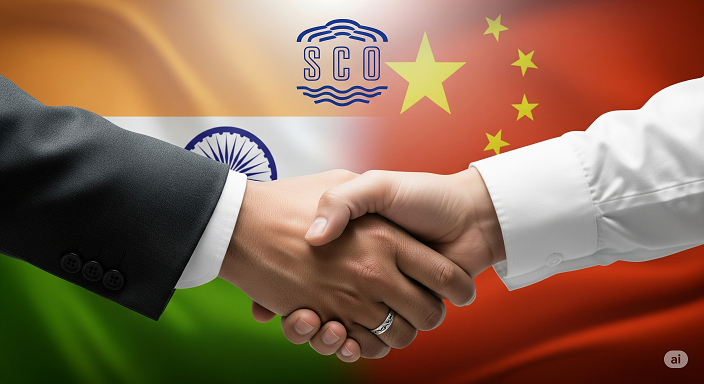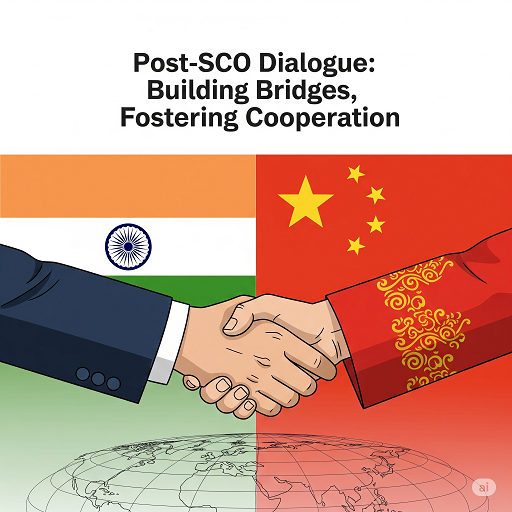
The political geography of Asia has always been in flux, but few bilateral relationships carry as much weight as that between India and China. With a combined population of nearly three billion and economies that together account for more than a quarter of global GDP, the trajectory of their ties influences not only South Asia but the global order. The Shanghai Cooperation Organisation (SCO) summit held this summer underscored the complexity of these ties: leaders spoke of friendship and cooperation, yet the shadows of military standoffs and competing strategic visions still linger.
Against this backdrop, India and China appear to be cautiously reopening doors—through youth exchanges, easing visa norms, and expanding trade. These steps do not erase the deep-seated mistrust along the Line of Actual Control (LAC), nor do they resolve decades of strategic competition. But they signal a pragmatic recognition: rivalry alone cannot define the future, particularly at a time when both countries face shifting global alignments, strained relations with Washington, and overlapping interests with Moscow.
A Fragile Reset After Years of Tension
India–China ties have been severely tested since the deadly Galwan clash of June 2020, which left soldiers dead on both sides and cast a long shadow over trust. Since then, disengagement talks have taken place in fits and starts, punctuated by military build-ups and counter-deployments. Even today, Indian Army commanders warn that Chinese troops, with their superior road infrastructure, could redeploy close to the border within hours, necessitating continued vigilance.
Yet, the recent SCO meeting in Kazakhstan and follow-up diplomatic engagements in Delhi suggest that both sides are trying to shift the narrative from confrontation to cautious cooperation. Chinese Foreign Minister Wang Yi’s message that India and China should see each other as “partners, not rivals” was an important signal, even if met with Indian skepticism. Prime Minister Narendra Modi, while reiterating the need for peace at the border, also spoke of broader regional cooperation.
This is not reconciliation—but it is a thaw. And it is being driven by three converging factors: the deteriorating US–China relationship, India’s own trade frictions with Washington, and the growing role of Russia as a geopolitical bridge.
The U.S. Factor: Friction Opens New Space
Ironically, Washington’s escalating economic confrontation with Beijing may be nudging India and China toward limited cooperation. The U.S.’s recent tariff escalations, particularly targeting Chinese exports, have shaken global supply chains. For India, which also faces protectionist trade pressures from the U.S., there is a recognition that pragmatic engagement with China can ease economic vulnerabilities.
The irony is striking: while New Delhi has, in recent years, deepened strategic coordination with the U.S. under the Quad framework, its economic frictions with Washington have widened. Agricultural exports, technology restrictions, and H-1B visa policies continue to create irritation. At the same time, the U.S. is wary of India’s continued energy imports from Russia, a relationship that complicates Washington’s broader sanctions regime.
China, facing a trade squeeze from Washington, has seized the moment to court India economically. Beijing’s envoy recently declared that “all Indian commodities” are welcome in the Chinese market, a pointed invitation at a time when India is searching for alternative export destinations. Whether this translates into genuine market access or remains diplomatic posturing is yet to be seen, but the offer marks a rhetorical shift.
Russia: The Bridge Between Rivals
Russia has emerged as an unlikely but important stabilizer in the India–China dynamic. Both New Delhi and Beijing maintain close ties with Moscow, though for different reasons. India continues to rely heavily on Russian defense supplies—ranging from fighter jets to the S-400 missile defense system—despite efforts to diversify. China, on the other hand, sees Russia as a strategic partner in counterbalancing Western power and as a key supplier of energy.
The war in Ukraine and Western sanctions have deepened Moscow’s dependence on both Asian giants. This triangulation has forced India and China into shared platforms—BRICS, SCO, and energy markets—where they must at least coordinate positions. During the recent SCO dialogues, India and China both supported calls for a “multipolar order,” aligning with Russia’s broader narrative of resisting Western dominance.
Moscow has also quietly encouraged India and China to maintain communication channels, seeing stability between the two as critical to its own strategic space. For Russia, the worst-case scenario would be an Indo-Chinese confrontation that fractures Asian solidarity against Western pressure.
Small Steps Forward: Visas, Youth, and Trade

Diplomatic thaws are rarely headline-grabbing, and the most telling signs of progress often lie in the details. In recent months, India has eased visa processes for senior Chinese business executives, particularly from tech and manufacturing firms like Xiaomi and Vivo, whose operations in India had previously been clouded by regulatory scrutiny. These steps, though limited, are seen as goodwill gestures to revive commercial flows.
Similarly, there has been movement on cultural and people-to-people exchanges. Pilgrimage routes are reopening, student exchanges are being encouraged, and youth dialogue forums are being revived under SCO and BRICS frameworks. Such measures are far from transformative, but they build constituencies of engagement that go beyond border disputes and political mistrust.
Trade, meanwhile, continues to be both a driver and a source of imbalance. China remains India’s largest trading partner, with bilateral trade crossing $135 billion in 2024. The deficit, heavily skewed in China’s favor, is a persistent Indian concern. But Indian exporters see opportunities in pharmaceuticals, agricultural products, and services, especially if China follows through on its promise of greater market access.
Strategic Restraints b/w India China : The LAC and the Indo-Pacific
For all the talk of thaw, neither side is letting its guard down along the border. India continues to expand its military infrastructure in Ladakh and Arunachal Pradesh, while China enhances its logistics networks in Tibet and Xinjiang. Indian military commanders emphasize that dialogue has not diminished the need for vigilance.
Moreover, India remains deeply invested in its Indo-Pacific partnerships, particularly with the U.S., Japan, and Australia through the Quad. Naval exercises in the Indian Ocean, defense technology cooperation, and intelligence sharing reflect India’s strategic hedging—cooperating with China economically while constraining it geopolitically.
Beijing, for its part, continues to court India diplomatically but also presses its regional influence through Pakistan and the Belt and Road Initiative. New Delhi’s refusal to endorse BRI remains a sore point, as does China’s support for Pakistan on issues like Kashmir.
The Road Ahead for India China: Building Trust in Increments
The phrase “slow diplomatic thaw” captures the essence of India–China relations today. Trust is still fragile, and the shadow of Galwan has not faded. Yet, the geopolitical environment is pushing both countries toward limited accommodation. With Washington’s unpredictability under the Trump administration, with Moscow seeking Asian solidarity, and with global economic headwinds, neither New Delhi nor Beijing can afford unrelenting hostility.
The future of India–China relations may lie in compartmentalization: managing differences along the border while expanding cooperation in trade, youth exchanges, technology, and regional forums. This does not mean strategic competition will disappear; rather, it suggests a coexistence shaped by pragmatism more than ideology.
As India eases visas for Chinese executives and China opens its markets to Indian goods, bridges—both literal and figurative—are being built. They may not yet be strong enough to carry the full weight of bilateral expectations, but they mark a shift from the isolation of the past few years.
Read also : How to Make Khamman Dhokla: A Complete Guide to Gujarat’s Beloved Snack
In Asia’s crowded geopolitical theatre, India and China cannot escape each other. The challenge is whether they can turn fragile bridges into durable pathways of trust. For now, the thaw is slow, but it is real—and in a world of mounting rivalries, even small steps toward dialogue deserve attention.
